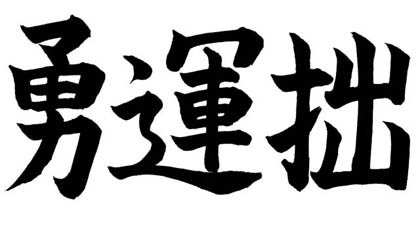Heijoshin 平常心
 In Budo, maybe more specifically in sword/katana related arts, there is an important term/concept which is Heijoshin. Heijoshin is a three kanji word, the first one “Hei” means calm, peaceful, steady. The second one “jo” means always, constant. The third one “Shin” means mind or hearth, the whole inner essence of the individual.
In Budo, maybe more specifically in sword/katana related arts, there is an important term/concept which is Heijoshin. Heijoshin is a three kanji word, the first one “Hei” means calm, peaceful, steady. The second one “jo” means always, constant. The third one “Shin” means mind or hearth, the whole inner essence of the individual.
So a final interpretation could be “Keeping your state of mind all the time/in all situation”.
This idea of staying calm in any situation looks of course logical but is not so simple to apply. Practicing every day, keeping in mind that iaido is build on top of a Bujutsu base (Origin of our Budo – Martial art). Practicing with this in mind is realizing that every encounter with an enemy (Kata) is a question of life and death.
Even today were hopefully such between life and death situation (Real combat) have disapeared, how many time did not you had the feeling (and not only the feeling) of losing your ways. When making a demonstration in front of an important audience, during an examination or a competion (Taikai).
In kendo there is a term to describe the states of mind you should avoid/master. This term is “Shikai” and can be roughly translated as the “4 things to avoid” related to your state of mind, let’s list them:
– Kyo: Surprise (surprise)
– Ku: Fear (crainte)
– Gi: Doubt (doute)
– Waku: Confusion (hésitation)
These are the four states of the mind you do not want to fall in during a Kendo/Iaido competition, examination or demonstration. So being able to master your stress, avoiding to lose your temper and stay calm in order to think clearly, execute the proper technique and make the right decision can be described as “Heijoshin”. This can also be linked to the teaching “to be able to defeat the other, first conquer-yourself”.
When reaching higher grade, practicing kumitachi, the “Kendo no kata” for example with a Habiki (Sword replica) can make you suddenly realize such states of fear/doubt, facing someone with a real blade in a combat situation (Kata) even when it is a partner not an ennemy and a predefined scenario.
Being mentaly involved in your combat either real (Kendo), imaginary (Iaido) or during Kumitachi practice allows you to work on mastering your state of mind and maybe achieve the sate of “Mushin” translated as “Empty mind” but rather meaning open/free mind that allows you to react/respond instantly to any attack.
Posted: February 22nd, 2010 under Iaido, Kendo.
Tags: Gi, Heijoshin, Ku, Kyo, Shikai, Waku



